Project SUNSHINE definitely takes the prize for “most intentionally-misleading title of a government program.” The goal of SUNSHINE (co-sponsored by the Atomic Energy Commission and RAND) was to figure out what the impact radioactive fallout from American nuclear testing was on the world population. The initial study was started in 1953, and involved checking biological material for the the radioactive fission product Strontium-90, with an attempt to correlate Sr-90 levels with various known nuclear test series. Not exactly what you think of when you hear the term “sunshine,” eh?
It actually gets much creepier than just the confusing name. The “biological material” they were studying was, well, dead organic matter. What kind of organic matter, specifically? The dataset for a “pre-pilot” study on Strontium-90 intake, was a real witches brew:
- “Wisconsin cheese (1 month old)”
- “clam shells (Long Island)”
- “Wisconsin cat bone”
- “Montana cat (6 months, fed on milk from free-range cows)”
- “stillborn, full term baby (Chicago)”
- “rib from a Harvard man”
Pardon me while I count my ribs… and cats… and… well… yuck. You can’t make this stuff up. Well, I can’t, anyway. Here’s your creepy meeting transcript of the week, from the planning of SUNSHINE: “Dr. Libby commented on the difficulty of obtaining human samples, and suggested that stillborn babies, which are often turned over to the physician for disposal, might be a practical source.”1
Anyway — the document I wanted to share had nothing to do with the sample sources, but I got a little distracted while poking around in the SUNSHINE literature, and couldn’t not pass that on.
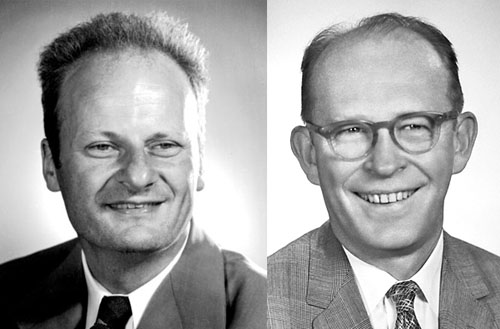
Hans Bethe and W.F. Libby
The letter in question comes from 1954, after SUNSHINE had been completed. It’s a request from December 1954 from the well-coifed Hans Bethe to the aforementioned Willard F. Libby, the physical chemist best known as the inventor of radiocarbon dating (for which he would win a Nobel Prize, in 1960), and in 1954 one of the five Commissioners of the AEC.3 In the letter, Bethe is arguing in favor of SUNSHINE’s declassification — and his justifications are not necessarily what you might expect.4
Bethe started out by noting that even in the summer of 1953, when SUNSHINE was being finished up, they (it seems that Bethe and Libby were both there) thought that it would “be highly desirable to declassify a large part of project SUNSHINE.” Bethe thought the matter has gotten rather urgent:
I still feel the same way about this, and I think the arguments for declassification have become far stronger than they were in 1953. There is real unrest both in this country and abroad concerning the long-range as well as short-range radioactivity, and it would, in my opinion, greatly allay the fears of the public if the truth were published.
There’s the kicker: Bethe was convinced that SUNSHINE will show that fallout from testing isn’t as big a problem as people thought it was. Releasing SUNSHINE wouldn’t be a matter of propaganda (and holding it back wasn’t a matter of covering it up), in Bethe’s mind — it would simply be getting the facts out.
And why might people suddenly be getting concerned about nuclear fallout?
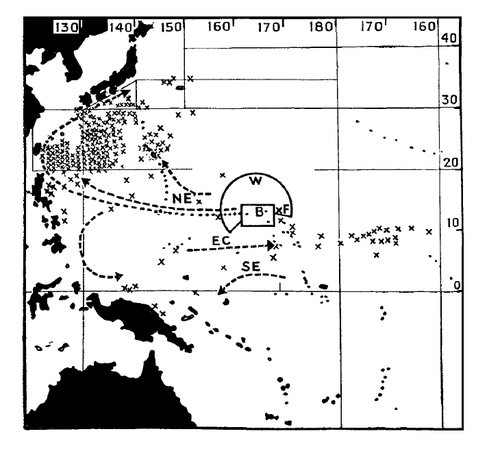
Map showing points (X) where contaminated fish were caught or where the sea was found to be excessively radioactive, following the Castle Bravo nuclear test.
No doubt because of all of the attention that the Castle BRAVO nuclear test had gotten with respects to high amounts of fallout finding its way into all sorts of biological systems far from its source — like the radioactive tuna that was caught for weeks afterwards off the waters of Japan.
Bethe understood, though, that the classification reasons holding back the publication of SUNSHINE were non-trivial. SUNSHINE studies the deposition of fission products following testing, and to make much sense of that, you had to know the fission yields from the tests. If you knew the fission yields, you’d know quite a lot about American nuclear weapons — especially if you knew the fission yield of the Ivy MIKE test, the first H-bomb.
Why? Because knowing the fission component of the first H-bomb test would possibly give away all sorts of information about the Teller-Ulam design. Multi-stage H-bombs have a reasonably large fission trigger that ignites the fusion fuel, which then again induces more fission in a “natural” uranium tamper. In the case of MIKE, 77% of the total 10.4 megaton yield came from the final fission stage. Knowing that would be a good hint as to the composition of the American H-bombs, and was not something they wanted to share with the USSR.
But Bethe thought you could get around this:
I believe the story of SUNSHINE could be published without giving away any information about our H-bombs: it is merely necessary to put the permissible accumulated yield in terms of fission yield rather than total yield.
In other words, if you just talked of fission yield — and didn’t give the total yield — you wouldn’t be able to figure out how much of the yield was not fission, and thus the high disparity (which would be a big red flag for a weapons designer) would be hidden.
Bethe also thought that they should publish the fallout data from the H-bomb tests (likely including those from the CASTLE series). Bethe didn’t think that information would give away any design information, but it was clear that others were suspicious. Bethe put the question to a test: he asked Philip Morrison to try and figure out how an H-bomb worked from just published stories about the Castle BRAVO fallout accident.
Morrison at that point had no access to classified information. He had been part of the Manhattan Project, and so knew quite a bit about fission weapons, but had been cut out of the classified world by the time the H-bomb had come along. (More on Morrison’s security clearance another time — lots of interesting stories there.)
Morrison’s conclusions (oddly title “FISSION ENERGY IN IVY,” even though it was about BRAVO) are attached to Bethe’s letter. In many ways it is an analysis typical of a somewhat cocky physicist: things are described as “easy” and conclusions are lead to “clearly” and everything is stated as if it is pretty obvious and pretty straightforward. Morrison concludes that the total fission yield of BRAVO (again, misidentified as IVY) is between 0.2Mt and 0.6Mt, and that most of the fission must have been from the fission primary that started the reactions. In reality, 10Mt of the 15Mt total yield was from fission, which is why it was such a “dirty” shot.
Bethe took this as evidence that indeed, looking at just the fallout alone, you couldn’t figure out how much of the explosion was from fission yield, and thus the design information was safe: “As Morrison’s report shows, it seems to be easy to draw entirely wrong conclusions from the fall-out data.”
Why Morrison got this wrong is a little mysterious to me. Ralph Lapp had managed to conclude, more or less correctly, that there was a third “dirty” fission stage, and had popularized the idea enough that it trickled into Life magazine in December 1955. But Bethe thought Morrison’s analysis was more or less sound, given his lack of detailed information. It’s a weird thing to conclude, based on one study, that some piece of information is fundamentally unknowable, when you already know what the piece of information is.
Speaking of speculating based on missing information, part of Bethe’s letter is redacted, for reasons I do not know. His conclusion makes it pretty clear it has to do with this absolute vs. fission yield/fallout issue, though.
Bethe concludes: “I believe it would greatly improve international feeling about our Pacific tests if we were to publish the correct story of SUNSHINE and of fall-out.”
Libby would come around to Bethe’s position and push for declassification. In Libby’s mind, like Bethe’s, SUNSHINE showed that the world wasn’t going to become mutated just because of a little testing in the Pacific. Furthermore, he also came to believe that you could shut down a lot of the anti-nuclear testing demands by just showing people that you were paying close attention to this sort of thing — by the time of Operation Redwing (1956), he felt that this sort of disclosure had already made the international community more friendly to US testing.
It wasn’t until 1956 that the declassification eventually occurred, however, and even then, a lot of things were removed. (The “Amended*” in the RAND report cover page above is because it was “Amended to remove classified data; otherwise the report remains unchanged and represents the 1953 estimate of the fallout problem.”) Of course, by that point it was clear that the Soviets had already figured out how to make an H-bomb work.
Also! I will be giving a talk this Friday at the annual meeting of the Society for Historians of American Foreign Relations (SHAFR) in Hartford, CT. Just putting that out there.
- Minutes of the 36th Meeting of the General Advisory Committee to the U.S. Atomic Energy Commission (17, 18, and 19 August 1953), copy in the OHP Marshall Islands Document Collection. [
]
- E.g. E.A. Martell, “Strontium-90 Concentration Data for Biological Materials, Soils, Waters and Air Filters,” Project Sunshine Bulletin No. 12, [AECU-3297(Rev.)], (1 August 1956); human bone data listings start on page 29. [
]
- Libby was also the husband of Leona Woods, which I didn’t realize. Marshall was the only woman who had a role in the development of CP-1, the first nuclear reactor, and stands out quite conspicuously in the Met Lab photographs. [
]
- Citation: Hans Bethe to W.F. Libby (17 December 1954), copy in Nuclear Testing Archive, Las Vegas, NV, document NV0032161. [
]
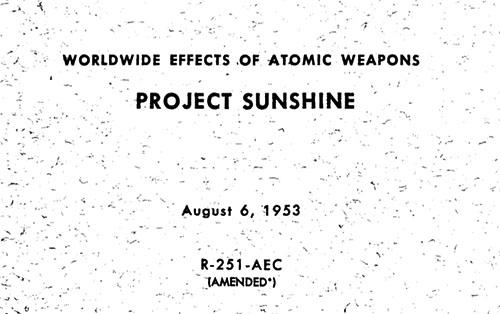
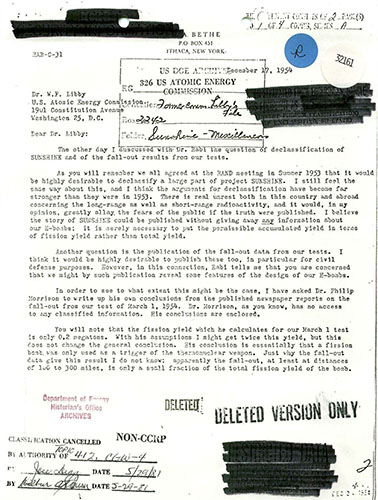
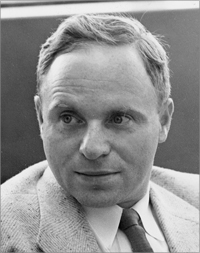
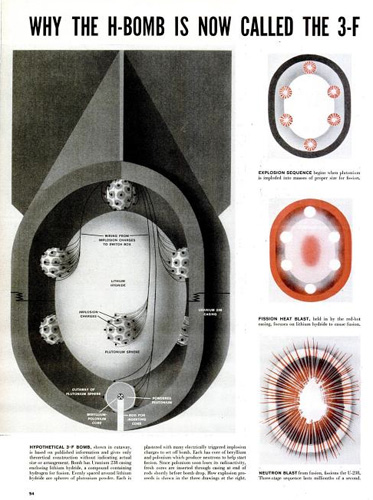



Less well-known and more humorous fact about Willard Libby: Libby was also a proponent of civil defense. In the early 1960s, as interest in fallout shelters was intensifying, Libby promoted an inexpensive shelter constructed out of old tires and railroad ties. When that shelter burned down in a brushfire—during the October 1962 Cuban Missile Crisis, no less—Libby’s former colleague Leo Szilard, the physicist and arms control advocate, quipped that the incident proved not only “that God exists, but that He has a sense of humor.”
Another reason Libby came around to Bethe’s side was that he thought it would make getting tissue samples for Sunshine easier. Apparently the supply of stillborn infants “was cut off…with no signs of rejuvenating” after the AEC hired a law firm to actually took a look at the laws on “body snatching.” Thus Libby’s comment, “If anyone knows how to do a good job of body snatching, they will really be serving their country.”
Creepy indeed.
I seem to remember the term “sunshine units” was briefly used to describe the “strontium unit” (a measure of Sr90 contamination in bone). I guess this originated with the “Sunshine project” as a cutesie way to categorize Sr-90 uptake to make it seem harmless. I understand the term eventually fell into disuse due to public ridicule.
http://books.google.com/books?id=0Cv_E3yLHG4C&pg=PA329&lpg=PA329&dq=sunshine+units+radiation&source=bl&ots=YFBsZkWsOc&sig=VZHEgjy0_AnG5BvsYZY_3Z-tvVs&hl=en
[…] Weekly Document: Bethe on SUNSHINE and Fallout (1954) (nuclearsecrecy.com) […]
“I deal in a number of controversial subjects, but I try to keep the number down.” — that’s pretty amusing. I’m not sure I trust Khan’s 1959 numbers on low radiation doses, though; a lot of study has been done since then. Even acknowledging that this sort of work is heavily politicized, the late-1950s approach to low dosages seems to have been really much too cavalier, as the down-winders, uranium miners, and site workers found out many decades later.
[…] Weekly Document: Bethe on SUNSHINE and Fallout (1954) (nuclearsecrecy.com) […]
Hello…
I am wondering about the original document by Y. Y. Nishiwaki 1955 that provided the basis of the radioactive fish/water samples after Castle-Bravo. I would like very much to locate a copy of the original document (or just the original figure). Does it exist? Can someone help me? I only have the Lancet version.
Aloha
A